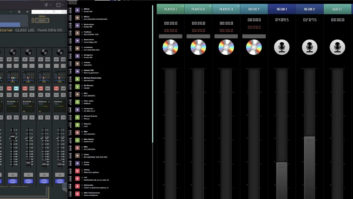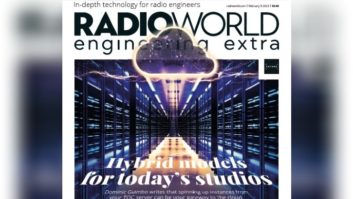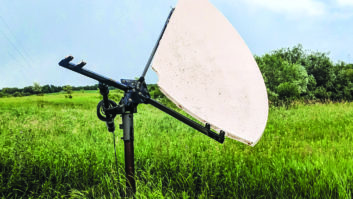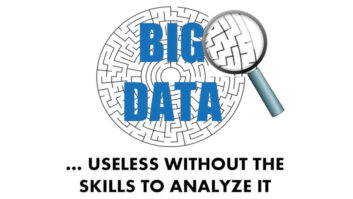As radio moved from analog technology into the digital age, it has redefined itself. Once thought of as a medium that provided news and entertainment in audio form, it has been restructured as a multimedia content provider.
As the digital age matures, it again may need to redefine itself, this time as a data center.

A Microsoft graphic explains Windows Azure, a cloud services operating system. Such a transition may be a leap for some; but according to A.J. Janitschek, director of program and operations support for Radio Free Asia, who talked about cloud computing at the recent NAB Show, coming to grips with this concept gives some direction to radio’s future IT operations.
SaaS, PaaS, IaaS
Cloud computing is simply defined as using the Internet for tasks you usually accomplish on your computer.
The end user in a cloud environment need not be concerned about the location of applications or data; he or she only needs to know that they exist and they work.
Advantages for developers include efficient resource utilization, on-demand scalability and minimal capital investment. For consumers, working in the cloud provides software/server-free computing, along with access to your data wherever you have Internet access. Business users can outsource the computing infrastructure and focus on their core competencies.
The bottom line is higher efficiencies with lower costs. The growth of netbook computing is one validation of the concept.
Essential characteristics of cloud computing include on-demand self-service, broad network access, resource pooling, rapid elasticity and measured service. It provides the opportunity for small to medium-sized stations to have access to applications and services they otherwise could not afford.
Cloud computing usually is delivered in one of three ways, described as Software as a Service (SaaS), Platform as a Service (PaaS) and Infrastructure as a Service (IaaS).
With SaaS, vendors license applications to customers for use on-demand. Examples include Google Apps and SalesForce. Janitschek adds that anyone using Gmail has one foot in cloud computing already.
SalesForce.com is another example. It distributes business software via subscriptions and is hosted offsite. It is probably best known for its Customer Relationship Management (CRM) products.
With PaaS, the provider delivers a computing platform where users can develop, test, deploy, host and maintain applications in the same integrated environment. Examples include BungeeLabs and Microsoft Azure.
Janitschek quotes Microsoft CEO Steve Ballmer, who declared: “We’re betting our future on cloud computing.”
Infrastructure as a Service means the buyer relies on the service provider’s equipment, and the vendor provides virtual machines and storage.
With IaaS, users may realize an economy of scale through volume operations. There is no IT facility, no maintenance and applications and servers stay current. Operating costs are reduced through pay-per-use, and finally, stations can focus on the core activities of broadcasting while outsourcing IT operations.
A full rethink
Embracing cloud computing requires a complete rethinking of the design, operation and planning of a station’s data center.
While the broadcast community is just waking up to cloud computing, other industries such as financial services, utilities, technology, healthcare, insurance and government are already there. One example Janitschek cites is the city of Orlando, which reduced its e-mail costs by 60 percent using Google Apps. It is also one of the first cities to switch all of its employees to Gmail.
While cloud computing appears to offer many advantages over the traditional data center model, it is not a perfect world.
Issues that users need to understand include abuse and ill-intended use; insecure application programming; malicious insiders; shared technology vulnerabilities; data loss and leakage; account, service and data hijacking; and unknown risk profiles.
Bandwidth limitations may prevent moving very large media files in and out of the cloud quickly. More intangible concerns with cloud computing include a loss of control as well as trust issues around security and privacy.
Some of these intangibles can be addressed by using a hybrid model with a private cloud built within a company’s firewall to provide greater data security. Some applications are outsourced to the public cloud, while more sensitive areas are kept in-house.
Janitschek notes that the traditional alternative to cloud computing is designing and building a large data center in-house. This entails painstaking work with 3D CAD programs for space utilization, and predictive analysis software for energy and cooling data.
He described an Uptime Institute study that found power consumption in data centers has increased more than 600 percent in just seven years. The trend for increased heat load is also expected to rise in the future. The option of switching to cloud computing may not only be faster, but cheaper.
Janitschek concluded his NAB presentation by describing some early adopters of cloud computing for broadcast operations. He said NPR and Sirius Satellite are using Isilon’s NAS (Network-Attached Storage) for media storage. Both organizations employ large numbers of media production workstations and media processing servers. NAS allows centralized storage of large amounts of media that can be accessed via the Internet at broadcast centers across the country. In the case of NPR, Isilon also provides replication software for disaster recovery preparedness.
Radio Free Asia is venturing into this new technology with Ubuntu Enterprise Cloud (UEC) to develop a private cloud to link RFA’s global operations. UEC is Linux-based open-source software that is compatible with Amazon’s EC2 public cloud applications.
Interest vs. demand
Broadcast manufacturers are also looking to the clouds.
Don Backus, vice president of sales and marketing at ENCO Systems, said, “We’ve been doing some R&D on cloud computing, especially in terms of resource sharing.
“Two issues concern us. The reliability of the infrastructure may result in unacceptable latency delays. Also, rights management can be a problem if content is delivered across multiple platforms.
“With time and effort, these issues can be addressed,” Backus continued. “Some of our customers have expressed an enthusiasm for the concept, but there does not appear to be demand for a product yet.”
At RCS, President/CEO Philippe Generali said two of the company’s products, MediaBase and Media Monitors, use the cloud to make data about radio stations and advertising available to its customers in near real-time. A third product that uses the cloud, MusicPoint, is due out later this year.
“As costs for bandwidth and storage continue to drop, we see more opportunities for broadcasters to take advantage of this technology,” he said.
Generali noted that security is an ongoing concern, and there is the potential for data to be accessed illegally; but so far, “the techies are ahead of the gangsters.”
Rights management is another issue; Generali recommends users develop a policy for copyright management as part of the planning process if they do not own all the content they are planning to make available.

A.J. Janitschek of Radio Free Asia discusses cloud computing at the recent NAB Show. Photo by Jim Peck Jim Roberts, product manager for datacast systems at Broadcast Electronics, thinks cloud computing could be the next disruptive technology to hit radio broadcasting.
“Eventually, the cloud will be where broadcasters store and share most of their data. It definitely makes sense for status and control of transmitters, and for stations to share news stories and actualities.”
Enabling program directors to program stations from the cloud is also promising. Other areas may be problematic.
“Groups of stations have discussed combining music in a single database. Issues often arise about which versions of songs to include and whether EOM tones are attached.”
He said that storing financial or playlist data in the cloud can raise some concerns over confidentiality.
“There are two facets to the trust issue. First you need to believe in the integrity of the organization you are dealing with. Second, you have to believe in their security measures so that no one can access or use your data without consent.”
Roberts said BE’s product line called “The Radio Experience” was an early adopter of cloud computing, beginning five years ago with its Message Manager program.
“At first stations didn’t like the idea of having their data in the cloud. Over time they have warmed up to the concept.”
Cloud computing is also on the air. “Cloud Computing Radio” delivers an ongoing series of podcast interviews with cloud computing newsmakers. CCR is produced and hosted by broadcast journalist and technology consultant Tom Tucker. Podcasts are available at iTunes and distributed to targeted groups across social networks such as LinkedIn, Facebook and Twitter.
Cloud computing offers the potential of freeing broadcasters from the constraints of operating from a single geographic location by making its content available wherever an Internet connection is available. It remains to be seen if the cloud can deliver the high quality-of-service essential for production and delivery of content to today’s critical audiences. While cloud computing is still in its infancy in the broadcast industry, its benefits, especially financial, mean that it may be set to grow quickly.
Tom Vernon is a long-time contributor to Radio World. He wrote about Arno Meyer of Belar in the June 16 issue.












